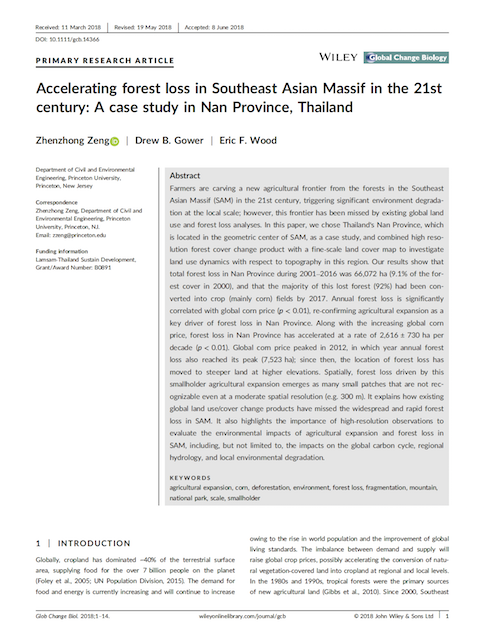Accelerating forest loss in Southeast Asian Massif in the 21st century: A case study in Nan Province, Thailand

Zeng, Z., Gower, D.B., Wood, E.F. (2017) “Accelerating forest loss in Southeast Asian Massif in the 21st century: A case study in Nan Province, Thailand”, Global Change Biology, doi:10.1111/gcb.14366
Abstract:Farmers are carving a new agricultural frontier from the forests in the Southeast Asian Massif (SAM) in the 21st century, triggering significant environment degradation at the local scale; however, this frontier has been missed by existing global land use and forest loss analyses. In this paper, we chose Thailand’s Nan Province, which is located in the geometric center of SAM, as a case study, and combined high resolution forest cover change product with a fine‐scale land cover map to investigate land use dynamics with respect to topography in this region. Our results show that total forest loss in Nan Province during 2001–2016 was 66,072 ha (9.1% of the forest cover in 2000), and that the majority of this lost forest (92%) had been converted into crop (mainly corn) fields by 2017. Annual forest loss is significantly correlated with global corn price (p < 0.01), re‐confirming agricultural expansion as a key driver of forest loss in Nan Province. Along with the increasing global corn price, forest loss in Nan Province has accelerated at a rate of 2,616 ± 730 ha per decade (p < 0.01). Global corn price peaked in 2012, in which year annual forest loss also reached its peak (7,523 ha); since then, the location of forest loss has moved to steeper land at higher elevations. Spatially, forest loss driven by this smallholder agricultural expansion emerges as many small patches that are not recognizable even at a moderate spatial resolution (e.g. 300 m). It explains how existing global land use/cover change products have missed the widespread and rapid forest loss in SAM. It also highlights the importance of high‐resolution observations to evaluate the environmental impacts of agricultural expansion and forest loss in SAM, including, but not limited to, the impacts on the global carbon cycle, regional hydrology, and local environmental degradation.
